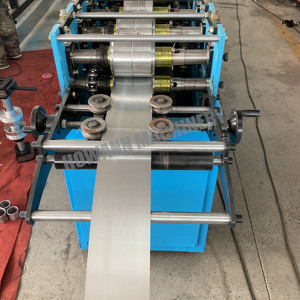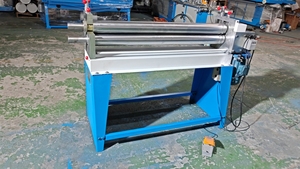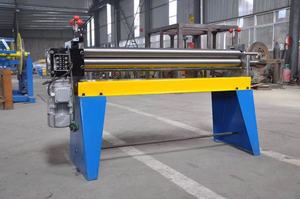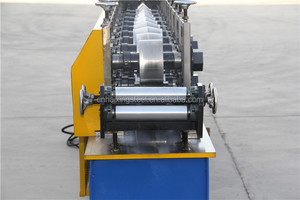
All categories
Featured selections
Trade Assurance
Buyer Central
Help Center
Get the app
Become a supplier

(7754 products available)


















































Metal stud and track roll forming machines produce metal studs and tracks used as structural framework in construction. These typically come in two main varieties:
Manual control machine
Manual metal stud and track roll forming machines allow the operator to manually adjust the speed to form the metal cut. As the name suggests, he is in charge of everything, including moving, feeding the material into the machine, and starting/stopping the process. While straightforward and inexpensive, manual machines do not have the automation or precision of advanced control systems and may require more physical effort and time. His skill can also lead to a greater variability in track size. Nonetheless, it serves basic framing needs for small jobs or light use where automation is unnecessary. It is a simple solution with a low cost for businesses with limited budgets.
Automatic control machine
Automatic metal stud and track roll forming machines have a lot of exciting features. One of the most notable ones is the PLC (Programmable Logic Controller) that allows for flexible control and programmability to form various metal studs and tracks. In addition to the PLC, another high-tech component is the computer-controlled servo feeding system that ensures precise feeding of the metal sheet and consistent accuracy. An important feature for protecting the machine and preventing any damage is the active safety barriers and guards. Elements with varying configurations can be produced using the automatic machine, which also has the advantage of quicker setup times and lower labor costs. The precision of the servo automatic feeding system allows for mass production and better quality. Companies requiring high output volumes and efficiency should choose the automatic option, as it allows them to meet their needs quickly. Businesses looking for a more advanced method that is faster and can produce more may want to consider this particular machine because of its commitment to yield and functional ability.
The specifications vary according to the requirement and type of the machine. Here are some of the common specifications.
Metal Stud Size
The machine can make metal studs with different lengths and thicknesses. The usual size is 50mmx 0.6-1.2mm. However, machines can manufacture wider and thicker studs for different projects.
Track Size
The metal track has different sizes and thicknesses, similar to the metal stud. The common size is 75mm x 0.6-1.2mm. The tracks are wider and thicker for heavier construction needs.
Blade System
The specification may vary according to the machine type. The blade has the usual size of 0.42m and works with 7.5 kw power. The working speed is about 1500-3000rpm. A larger diameter and higher speed are available in heavier machines.
Feeding System
The feeding system works with a servo motor system. The size of the roller is 12mm x 21 pieces, and it carries different gauges of materials. It has a power of 3kw and works at a speed of 50-80m/min.
PCB and Control System
The machine has a programmable logic control system and a printed circuit box. The human-machine interface has a 10-inch touch display to change different specifications and designs. The machines are controlled by PLC, and the feeding and cutting are done automatically. This helps to achieve perfect accuracy and repeatability of the process.
Power
Smaller machines run on a three-phase power of 5-12 kw, while bigger machines need more power. Larger machines form, cut, and feed with 15-22 kw power. The voltage is usually 380V, but it can be customized according to the requirement.
Speed
The roll forming machine makes studs and tracks at 8-15m/min. conventional speed. It can produce similar products at a faster speed without compromising quality.
Machine Size
The machine's length, width, and height depend on the type and can range from a few to several meters. The stand-alone machine can easily fit into any factory space, and the container type fits into a standard shipping container.
Cooling and lubrication
Depending on the type of machine, the lubrication may be manual or automatic. The coolant reservoir may hold 5-10 liters of coolant.
The specifications of the machine depend on requirements like the product's length, thickness, size, and speed. Different specifications are available for custom requirements.
These machines are built for constant use and heavy production. However, like all machines, they need timely maintenance to function properly. Suppliers would like to know the essential machine maintenance tips.
Clean the machine parts on a regular basis. This will help remove the waste material and any dust that has accumulated. The cleaning routine should include washing and drying any rolling parts and lubricating them afterwards. Oil any moving parts of the machine to keep it in good condition. This includes the guides, bearings, rollers, chains, and gears. The lubricants help to prevent wear and tear, reducing the need for repairs.
Parts that are damaged or worn out need immediate repair or replacement. Suppliers should keep a log of parts that are frequently damaged. It will help them to better prepare for the preventative maintenance schedule. The machine should be calibrated regularly to ensure that it is functioning within set manufacturing tolerances. Regularly trained professionals should carry out the machine adjustments and repairs. They have the knowledge and experience to do the work properly and safely. Finally, the user manual should be used to help in preventive maintenance and repairs. It has the details on the parts that need regular servicing and those that need lubrication.
Metal stud and track roll forming machines can be used in various industries. Here are a few key usage scenarios where metal studs are used to form specialty kinds of tracks.
Construction and Infrastructure:
In the construction of new homes, offices, hotels, hospitals, and large commercial establishments. Because of its lightweight, ease of transport, and speed of construction, metal tracks and studs are usually the framing material of choice.
Renovation and Remodeling:
When remodeling or renovating a part of a structure, interior walls need to be moved or replaced. Metal studs and tracks are ideal for such remodeling projects.
Industrial and Retail Spaces:
In retail spaces like supermarkets and warehouses, metal studs offer a cost-effective solution to creating large and well-spaced interior partitions and enclosures.
Healthcare Facilities:
In hospitals and other medical facilities, specifications call for framing materials that offer resistance to fire, mold, and pests. Metal studs are the framing material of choice in healthcare facilities, school buildings, and other public structures.
Office Buildings:
Metal stud framing is ideal for building lightweight partitions that can cope with the dynamic load of a workplace. Furthermore, the non-combustible nature of metal studs makes them suitable for office buildings that must adhere to strict fire safety regulations.
Clean Rooms and Controlled Environments:
In controlled environments like semiconductor fabs and pharmaceutical manufacturing facilities, metal studs are used because clean rooms demand that no mold or fungus can grow within the walls.
Before buying a metal stud and track roll forming machine, it is best to consider some key features of these machines. Also, the needs of the project or the specification of the metal framing to be produced should also be in line with the requirements of the machine.
By carefully considering these factors and aligning them with project needs, a suitable metal stud and track roll forming machine can be chosen to ensure smooth and efficient project execution.
Q1: What are metal studs made of?
A1: Metal studs are usually constructed of galvanized steel or aluminum alloy materials. The precise composition can vary depending on the particular metal stud variety and manufacturing technique.
Q2: What are the benefits of metal stud construction?
A2: Metal stud construction provides several benefits, including durability, Lightweight, fire resistance, pest resistance, and design flexibility, which are widely used in various construction projects.
Q3: Are metal studs heavier than wood?
A3: No, metal studs are much lighter than wood. One metal stud weighs the same as two wooden studs.
Q4: What is the lifespan of metal studs?
A4: Metal studs can last for more than 100 years if they are protected and maintained properly.